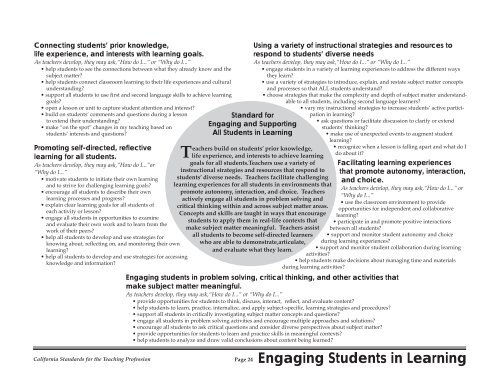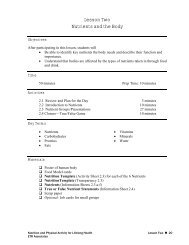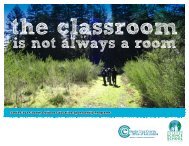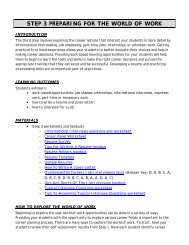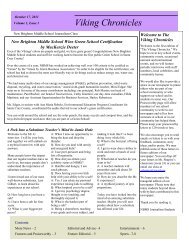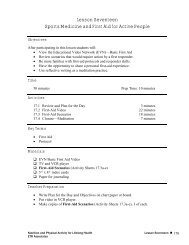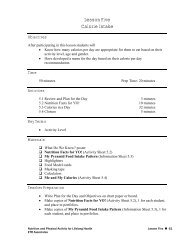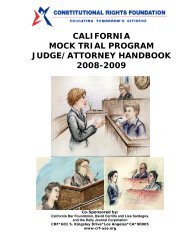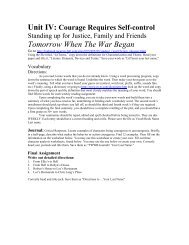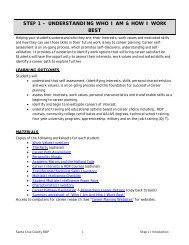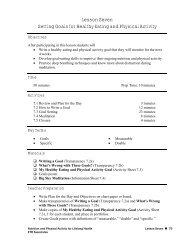California Standards for the Teaching Profession - Commission on ...
California Standards for the Teaching Profession - Commission on ...
California Standards for the Teaching Profession - Commission on ...
Create successful ePaper yourself
Turn your PDF publications into a flip-book with our unique Google optimized e-Paper software.
C<strong>on</strong>necting students’ prior knowledge,<br />
life experience, and interests with learning goals.<br />
As teachers develop, <str<strong>on</strong>g>the</str<strong>on</strong>g>y may ask,“How do I...” or “Why do I...”<br />
• help students to see <str<strong>on</strong>g>the</str<strong>on</strong>g> c<strong>on</strong>necti<strong>on</strong>s between what <str<strong>on</strong>g>the</str<strong>on</strong>g>y already know and <str<strong>on</strong>g>the</str<strong>on</strong>g><br />
subject matter<br />
• help students c<strong>on</strong>nect classroom learning to <str<strong>on</strong>g>the</str<strong>on</strong>g>ir life experiences and cultural<br />
understanding<br />
• support all students to use first and sec<strong>on</strong>d language skills to achieve learning<br />
goals<br />
• open a less<strong>on</strong> or unit to capture student attenti<strong>on</strong> and interest<br />
• build <strong>on</strong> students’ comments and questi<strong>on</strong>s during a less<strong>on</strong><br />
to extend <str<strong>on</strong>g>the</str<strong>on</strong>g>ir understanding<br />
• make “<strong>on</strong> <str<strong>on</strong>g>the</str<strong>on</strong>g> spot” changes in my teaching based <strong>on</strong><br />
students’ interests and questi<strong>on</strong>s<br />
Promoting self-directed, reflective<br />
learning <str<strong>on</strong>g>for</str<strong>on</strong>g> all students.<br />
As teachers develop, <str<strong>on</strong>g>the</str<strong>on</strong>g>y may ask,“How do I...”or<br />
“Why do I...”<br />
• motivate students to initiate <str<strong>on</strong>g>the</str<strong>on</strong>g>ir own learning<br />
and to strive <str<strong>on</strong>g>for</str<strong>on</strong>g> challenging learning goals<br />
• encourage all students to describe <str<strong>on</strong>g>the</str<strong>on</strong>g>ir own<br />
learning processes and progress<br />
• explain clear learning goals <str<strong>on</strong>g>for</str<strong>on</strong>g> all students of<br />
each activity or less<strong>on</strong><br />
• engage all students in opportunities to examine<br />
and evaluate <str<strong>on</strong>g>the</str<strong>on</strong>g>ir own work and to learn from <str<strong>on</strong>g>the</str<strong>on</strong>g><br />
work of <str<strong>on</strong>g>the</str<strong>on</strong>g>ir peers<br />
• help all students to develop and use strategies <str<strong>on</strong>g>for</str<strong>on</strong>g><br />
knowing about, reflecting <strong>on</strong>, and m<strong>on</strong>itoring <str<strong>on</strong>g>the</str<strong>on</strong>g>ir own<br />
learning<br />
• help all students to develop and use strategies <str<strong>on</strong>g>for</str<strong>on</strong>g> accessing<br />
knowledge and in<str<strong>on</strong>g>for</str<strong>on</strong>g>mati<strong>on</strong><br />
<str<strong>on</strong>g>Cali<str<strong>on</strong>g>for</str<strong>on</strong>g>nia</str<strong>on</strong>g> <str<strong>on</strong>g>Standards</str<strong>on</strong>g> <str<strong>on</strong>g>for</str<strong>on</strong>g> <str<strong>on</strong>g>the</str<strong>on</strong>g> <str<strong>on</strong>g>Teaching</str<strong>on</strong>g> <str<strong>on</strong>g>Professi<strong>on</strong></str<strong>on</strong>g><br />
Standard <str<strong>on</strong>g>for</str<strong>on</strong>g><br />
Engaging and Supporting<br />
All Students in Learning<br />
Teachers build <strong>on</strong> students’ prior knowledge,<br />
life experience, and interests to achieve learning<br />
goals <str<strong>on</strong>g>for</str<strong>on</strong>g> all students.Teachers use a variety of<br />
instructi<strong>on</strong>al strategies and resources that resp<strong>on</strong>d to<br />
students’ diverse needs. Teachers facilitate challenging<br />
learning experiences <str<strong>on</strong>g>for</str<strong>on</strong>g> all students in envir<strong>on</strong>ments that<br />
promote aut<strong>on</strong>omy, interacti<strong>on</strong>, and choice. Teachers<br />
actively engage all students in problem solving and<br />
critical thinking within and across subject matter areas.<br />
C<strong>on</strong>cepts and skills are taught in ways that encourage<br />
students to apply <str<strong>on</strong>g>the</str<strong>on</strong>g>m in real-life c<strong>on</strong>texts that<br />
make subject matter meaningful. Teachers assist<br />
all students to become self-directed learners<br />
who are able to dem<strong>on</strong>strate,articulate,<br />
and evaluate what <str<strong>on</strong>g>the</str<strong>on</strong>g>y learn.<br />
Using a variety of instructi<strong>on</strong>al strategies and resources to<br />
resp<strong>on</strong>d to students’ diverse needs<br />
As teachers develop, <str<strong>on</strong>g>the</str<strong>on</strong>g>y may ask,“How do I...” or “Why do I...”<br />
• engage students in a variety of learning experiences to address <str<strong>on</strong>g>the</str<strong>on</strong>g> different ways<br />
<str<strong>on</strong>g>the</str<strong>on</strong>g>y learn<br />
• use a variety of strategies to introduce, explain, and restate subject matter c<strong>on</strong>cepts<br />
and processes so that ALL students understand<br />
• choose strategies that make <str<strong>on</strong>g>the</str<strong>on</strong>g> complexity and depth of subject matter understandable<br />
to all students, including sec<strong>on</strong>d language learners<br />
• vary my instructi<strong>on</strong>al strategies to increase students’ active participati<strong>on</strong><br />
in learning<br />
• ask questi<strong>on</strong>s or facilitate discussi<strong>on</strong> to clarify or extend<br />
students’ thinking<br />
• make use of unexpected events to augment student<br />
learning<br />
Engaging students in problem solving, critical thinking, and o<str<strong>on</strong>g>the</str<strong>on</strong>g>r activities that<br />
make subject matter meaningful.<br />
As teachers develop, <str<strong>on</strong>g>the</str<strong>on</strong>g>y may ask,“How do I...” or “Why do I...”<br />
• provide opportunities <str<strong>on</strong>g>for</str<strong>on</strong>g> students to think, discuss, interact, reflect, and evaluate c<strong>on</strong>tent<br />
• help students to learn, practice, internalize, and apply subject-specific, learning strategies and procedures<br />
• support all students in critically investigating subject matter c<strong>on</strong>cepts and questi<strong>on</strong>s<br />
• engage all students in problem solving activities and encourage multiple approaches and soluti<strong>on</strong>s<br />
• encourage all students to ask critical questi<strong>on</strong>s and c<strong>on</strong>sider diverse perspectives about subject matter<br />
• provide opportunities <str<strong>on</strong>g>for</str<strong>on</strong>g> students to learn and practice skills in meaningful c<strong>on</strong>texts<br />
• help students to analyze and draw valid c<strong>on</strong>clusi<strong>on</strong>s about c<strong>on</strong>tent being learned<br />
Page 24<br />
• recognize when a less<strong>on</strong> is falling apart and what do I<br />
do about it<br />
Facilitating learning experiences<br />
that promote aut<strong>on</strong>omy, interacti<strong>on</strong>,<br />
and choice.<br />
As teachers develop, <str<strong>on</strong>g>the</str<strong>on</strong>g>y may ask,“How do I...” or<br />
“Why do I...”<br />
• use <str<strong>on</strong>g>the</str<strong>on</strong>g> classroom envir<strong>on</strong>ment to provide<br />
opportunities <str<strong>on</strong>g>for</str<strong>on</strong>g> independent and collaborative<br />
learning<br />
• participate in and promote positive interacti<strong>on</strong>s<br />
between all students<br />
• support and m<strong>on</strong>itor student aut<strong>on</strong>omy and choice<br />
during learning experiences<br />
• support and m<strong>on</strong>itor student collaborati<strong>on</strong> during learning<br />
activities<br />
• help students make decisi<strong>on</strong>s about managing time and materials<br />
during learning activities<br />
Engaging Students in Learning


